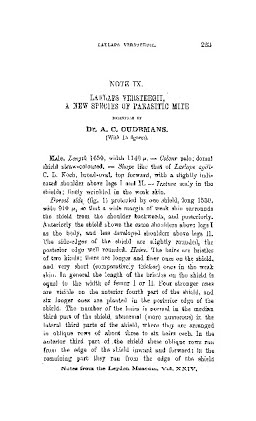1904
Laelaps Versteegii, a new species of Parasitic Mite
Publication
Publication
Notes from the Leyden Museum , Volume 24 - Issue 4 p. 223- 231
Male. Length 1650, width 1140 μ.— Colour pale; dorsal shield straw-coloured. — Shape like that of Laelaps agilis C. L. Koch, broad-oval, top forward, with a slightly indicated shoulder above legs I and II. — Texture scaly in the shields; finely wrinkled in the weak skin. Dorsal side (fig. 1) protected by one shield, long 1530, wide 910 μ, so that a wide margin of weak skin surrounds the shield from the shoulder backwards, and posteriorly. Anteriorly the shield shows the same shoulders above legs I as the body, and less developed shoulders above legs II. The side-edges of the shield are slightly rounded, the posterior edge well rounded. Hairs. The hairs are bristles of two kinds; there are longer and finer ones on the shield, and very short (comparatively thicker) ones in the weak skin. In general the length of the bristles on the shield is equal to the width of femur I or II. Four stronger ones are visible on the anterior fourth part of the shield, and six longer ones are planted in the posterior edge of the shield. The number of the hairs is normal in the median third part of the shield, abnormal (more numerous) in the lateral third parts of the shield, where they are arranged in oblique rows of about three to six hairs each. In the anterior third part of the shield these oblique rows run from the edge of the shield inward and forward; in the remaining part they run from the edge of the shield inward and backward. The weak skin (except a portion behind the shield, limited by the 6 long hairs which are planted in the posterior edge of the shield) is densely hairy; the hairs are here minute bristles. Four small vertical hairs are directed forward.
| Additional Metadata | |
|---|---|
| Notes from the Leyden Museum | |
| Released under the CC-BY 4.0 ("Attribution") License | |
| Organisation | Naturalis journals & series |
|
Oudemans, A. C. (1904). Laelaps Versteegii, a new species of Parasitic Mite. Notes from the Leyden Museum, 24(4), 223–231. |
|
